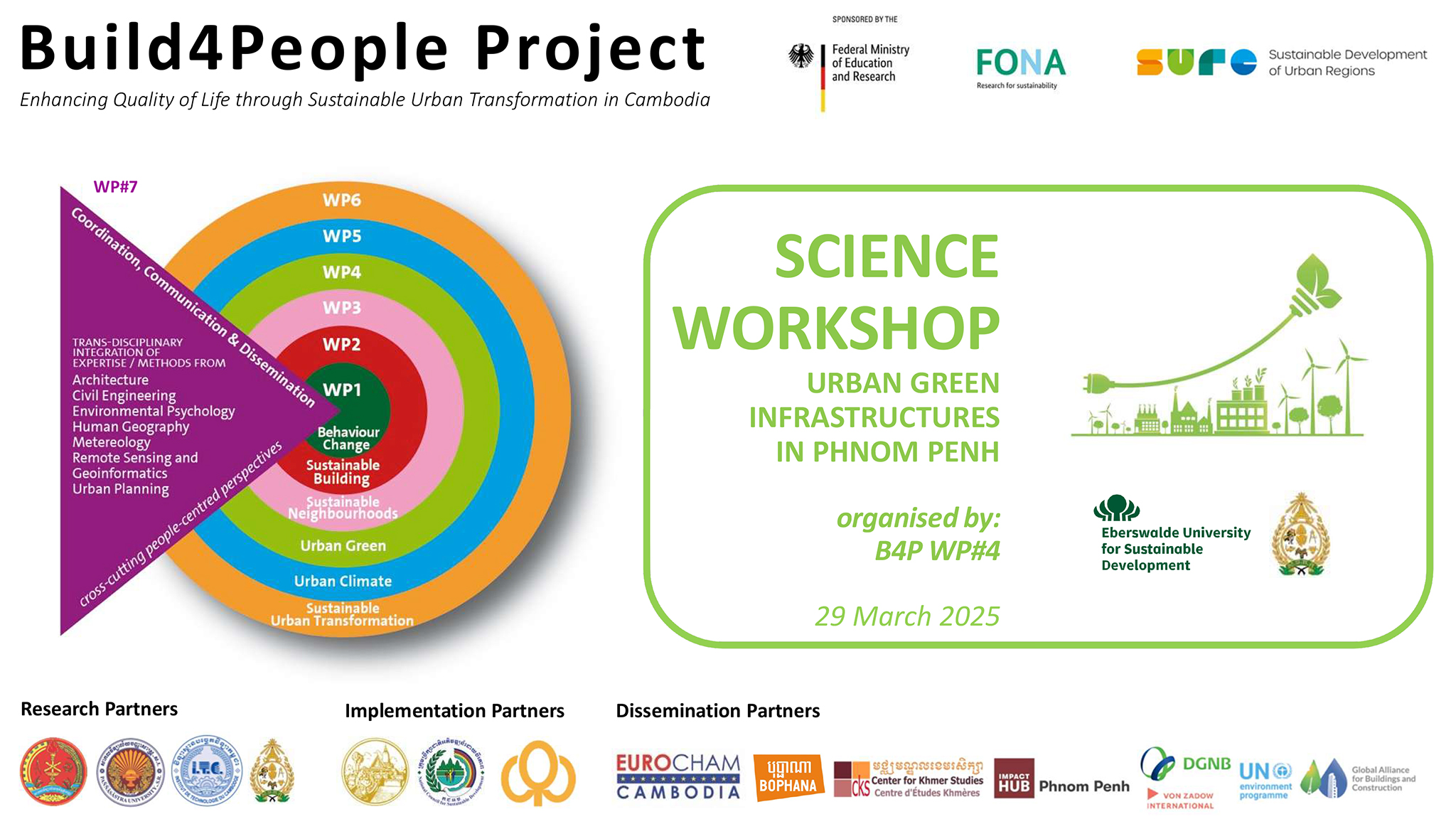On 29 March 2025, the Build4People Work Package “Urban Green Infrastructures” successfully held a Science Workshop at the Royal University of Agriculture (RUA), Phnom Penh. The workshop provided an interdisciplinary platform for knowledge exchange among experts, scholars, and young researchers from Cambodia and abroad. Its main focus was on sustainable urban transformation with a special emphasis on green and blue infrastructures as key pillars to improving the urban quality of life (UQoL) in Phnom Penh.

With in-depth presentations, case studies, and research findings sharing, the workshop emphasized the role of collaborative and data-driven approaches to shaping more liveable urban futures. Key highlights included the transformation of degraded sites into public spaces, sustainable riverfront urbanism, urban waterbody monitoring, and the practical use of citizen science applications in environmental planning.

The workshop started with the welcome speech by Dr Sanara Hor, Dean of Faculty of Land Management and Land Administration (FLMLA) at RUA. He welcomed all the guests from both Cambodia and Germany. He specifically mentioned the collaboration between Build4People Project and RUA how it brought fruitful research results last four years of RD phase.

Then, Build4People consortium leader Dr Michael Waibel, Hamburg University, (in his absence) shared his presentation on the general approaches of the Build4People project.

This was followed by a presentation by Ms. Sina Boramy (Graduate student, Czech University of Life Sciences) who explained about a comprehensive case study on converting the Stung Meanchey Dumpsite into a community park, based on local perceptions and international design references. Her presentation demonstrated significant potential for environmental restoration, public engagement, and improved urban health.

Then, Mr. Hor Keomayourado (Tianjin University) discussed a sustainable planning strategy for Preah Sisowath Quay, integrating Water Sensitive Urban Design (WSUD) principles. The presentation highlighted the use of rain gardens, permeable pavements, and stormwater retention strategies to enhance biodiversity and reduce urban heat.

After this, Mr. Ali Dia (Graduate student, Eberswalde University of Sustainable Development) shared findings from his remote sensing-based analysis of permanent waterbodies from 2016 to 2023. The results showed a 28.2 sq. km reduction in blue infrastructure, urging the need for data-driven interventions to protect urban water systems.

Then, Build4People Work Package “Behaviour Change” Leader Dr Anke Blöbaum presented about the Build4People Citizen Science APP development in regard of urban quality of life in Phnom Penh which is a cooperation between WP “Behaviour Change” and WP “Urban Green Infrastructures”. She highlighted how the proposed APP can collect citizen’s perception on UQoL from an urban green infrastructure perspective and how it will be useful for increasing participative decision-making and as a digital urban planning tool.

Finally, Prof. Dr. Jan-Peter Mund (Leader of Build4People Work Package “Urban Green Infrastructures”) closed the session by reflecting on the presented work and emphasizing the critical need for interdisciplinary approaches in urban environmental planning. He noted the strong contribution of student-led research and the ongoing development of innovative planning tools through Build4People.

All in all, the Build4People Work Package “Urban Green Infrastructures” Science Workshop 2025 highlighted the pressing environmental challenges Phnom Penh faces amid rapid urbanization. The event demonstrated that integrating data science, urban design, citizen participation, and policy frameworks is not just beneficial – but essential – for a sustainable and equitable urban future. With engaged contributions from Cambodian and international scholars, the Build4People project continues to pave the way for a transformative shift in Phnom Penh’s development trajectory—prioritizing sustainability, inclusivity, and urban quality of life.


